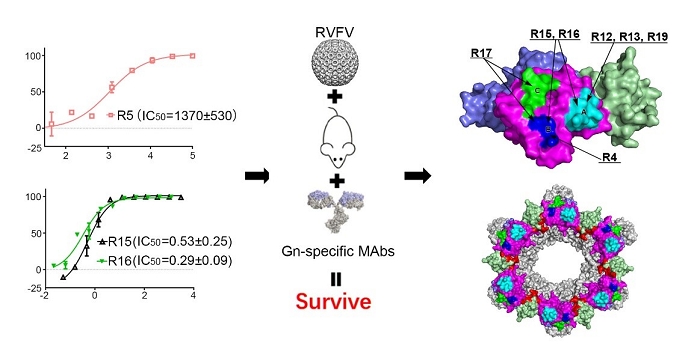Rift Valley fever virus (RVFV) is the causative agent of Rift Valley fever (RVF). It is a mosquito-borne pathogen, causing substantial morbidity and mortality in livestock and humans.From 2000 to June 2018, 4,830 cases of severe RVF in humans were reported to the World Health Organization (WHO), including 967 related deaths, with a case fatality rate (CFR) ofapproximately 20.0%.
Although formerly restricted to circulation in the African continent, RVFV spread, causing an epidemic in the Kingdom of Saudi Arabia and Yemen in 2000. In 2016, China reported its first imported case, a patient returning from Angola, a non-epidemic country. To date, there are no licensed human vaccines or therapeutics available. Thus, effective antivirals against RVFV are urgently needed.
RVFV belongs to the genus Phlebovirus under the FamilyPhenuiviridaein the order Bunyavirales. It contains a tripartite RNA-genome, encoding two glycoproteins on the viral envelope, Gn and Gc. Both of them are important components for virus entry and membrane fusion. We previously reported the structures of Gn from RVFV and from severe fever with thrombocytopenia syndrome virus (SFTSV), another Phlebovirus member (Wu et al., 2017, PNAS).
In this study, we report the isolation of monoclonal antibodies (MAbs) from a RVF convalescent patient, targeting the Gn and Gc. Among the nine sequenced MAbs, eight exclusively interacted with Gn, while only one associated with Gc. Notably, the Gn-specific MAbs exhibited much higher neutralizing activities in vitro and protection efficacies in mice against RVFV infection, compared to the Gc-specific MAb.
Further studies by flow cytometry indicated that all Gn-specific MAbs could bind to the soluble Gn and interfere with their binding to cells, thereby preventing infection by blocking the attachment of virions to host cells. Structural analysis of Gn complexed with four Gn-specific MAbs resulted in the definition of three antigenic patches (A, B and C) on Gn domain I. Both patches A and B were indicated to be the major neutralizing epitopes.
Their data represent the first study focusing on Gn and Gc MAbs stimulated by RVFV infection in humans, strongly indicating that human infection by RVFV stimulates a robust humoral immune response, and suggesting the high potential of antibody-based therapeutics.
Moreover, Gn seems to be the immune-dominant antigen in human RVFV infection, and two hotspot neutralizing targets on Gn were characterized, providing a structure-based rationale for designing vaccines against RVFV.
On April 1, 2019, the paper published online in Nature Microbiology by the research groups of Prof. YAN Jinghua from the CAS Key Laboratory of Microbial Physiological and Metabolic Engineering and Prof. GAO Fu (George Fu Gao) from CAS Key Laboratory of Pathogenic Microbiology and Immunology at Institute of Microbiology, Chinese Academy of Sciences (CAS).
The study was entitled: “Neutralization mechanism of human MAbs against Rift Valley fever virus”. Dr. WANG Qihui, Miss MA Tong, Dr. WU Yan and Dr. CHEN Zhihai are co-first authors on this paper.
This study was supported by the Strategic Priority Research Program of the Chinese Academy of Sciences and the National Science and Technology Major Projects. YAN and GAO are supported by the foundation of the NSFC Innovative Research Group.
YAN mainly focuses on developing therapeutic antibodies and vaccines. By collaboration with GAO, she has generated humanized MAbs against Middle East respiratory syndrome coronavirus (MERS-CoV), and isolated human neutralizing MAbs agaist Zika virus from a Zika convalescent patient. She also designed a subunit vaccine against MERS-CoV, which displayed effective protection in mice model.
URL: https://www.nature.com/articles/s41564-019-0411-z
